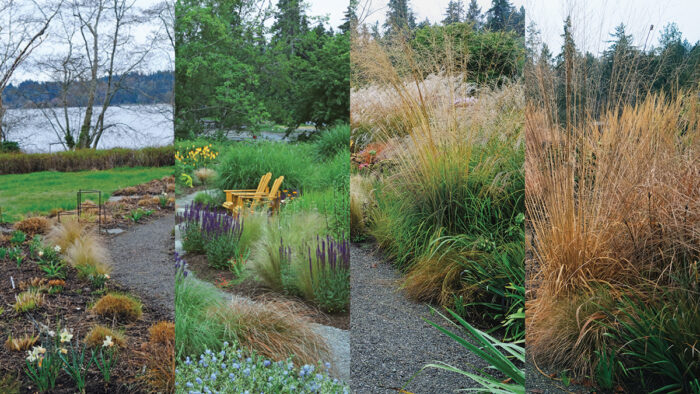
“Ornamental grasses only look good in fall.” If I had a dollar for every time I’ve heard this from my clients—or even fellow garden designers—I’d be able to retire. Even if someone is willing to concede that grasses can look good at other times of the year, they tend to think a grass-forward garden will only have impact if it inhabits acres of space, creating a meadow-like appearance. I don’t think any of this is true. Grasses can be the star of the show, creating the backbone in an all-season border of any size. And by adding plants with complementary colors and contrasting shapes, you can have a design that is beautiful most months of the year.
See more:
The Best Ornamental Grasses for Every Season
How to Divide Large Overgrown Ornamental Grasses
Let’s Argue About Plants Podcast Episode 147: Great Native Grasses
Build a Four-Season, Grass-Forward Garden: Plant IDs

A few years ago, I was faced with a challenge at my home in Poulsbo, Washington: an ugly patch of lawn that stretched along a property line. It was close to the shoreline and extremely close to a neighboring house. Moreover, the conditions in this location were harsh, with high winds coming off the nearby bay much of the year. But I didn’t want to install a heavy line of shrubs or trees and create a claustrophobic “garden room.” Instead, I planted a shelter band of mixed ornamental grasses that gave the new bed constant movement and interest. To that foundation, I added colorful plants that shine in different seasons, ensuring that this border always looks good. The result allows me to be in the garden, unseen by anyone, but still able to see the shoreline and beautiful surroundings. I even left a break in the grasses, so the setting sun hits my chair with its last rays. Designing this type of magical garden was easy; it just took the right kind of planning.
Select an array of different sizes and colors of ornamental grasses to maximize interest
Just like a bed filled with plain green conifers of a similar size would be boring, a border filled with grasses that all look the same wouldn’t be appealing either. My first step was to decide which grasses would create the main structure of the bed, and I chose an array of genera with varied colors and sizes. The mature height and width then determined placement.
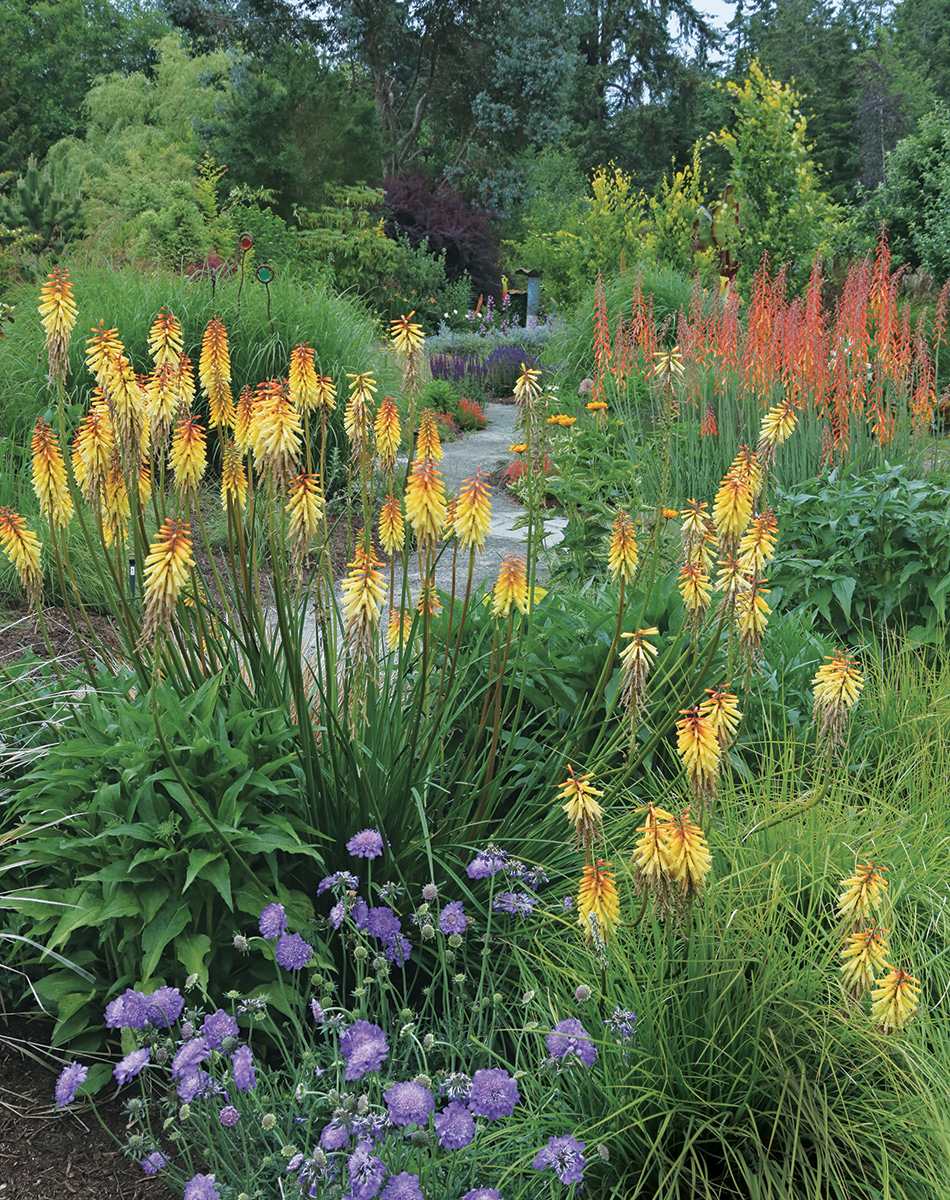
Large-scale grasses such as giant feather grass (Celtica gigantea, Zones 5–8) and ‘Skyracer’ purple moor grass (Molinia caerulea subsp. arundinacea ‘Skyracer’, Zones 5–8) were placed right along the property line to provide a dense backdrop and privacy screening. I then added groups of various medium-size grasses, including ‘Shenandoah’ switchgrass (Panicum virgatum ‘Shenandoah’, Zones 5–9) and ‘Blackhawks’ big bluestem (Andropogon gerardii ‘Blackhawks’, Zones 3–9), down the middle of the border before placing smaller tufted varieties such as little bluestem (Schizachyrium scoparium, Zones 3–9) and ‘Campo Azul’ autumn moor grass (Sesleria autumnalis ‘Campo Azul’, Zones 6–10) along the edges of the walkway. This sort of placement makes sense for a one-sided bed, but if you have a peninsula-style bed that can be seen from all sides, you can put larger specimens down the middle and layer plants on both sides.
Hate flopping? Don’t irrigate
One key that helps all ornamental grasses to stay upright and beautiful is avoiding excessive irrigation. Most grasses are somewhat drought tolerant by nature. Too much water or fertilizer and they will fl op. New additions can be watered by hand until established. I also recommend mulching garden beds once a year, which helps with water retention.
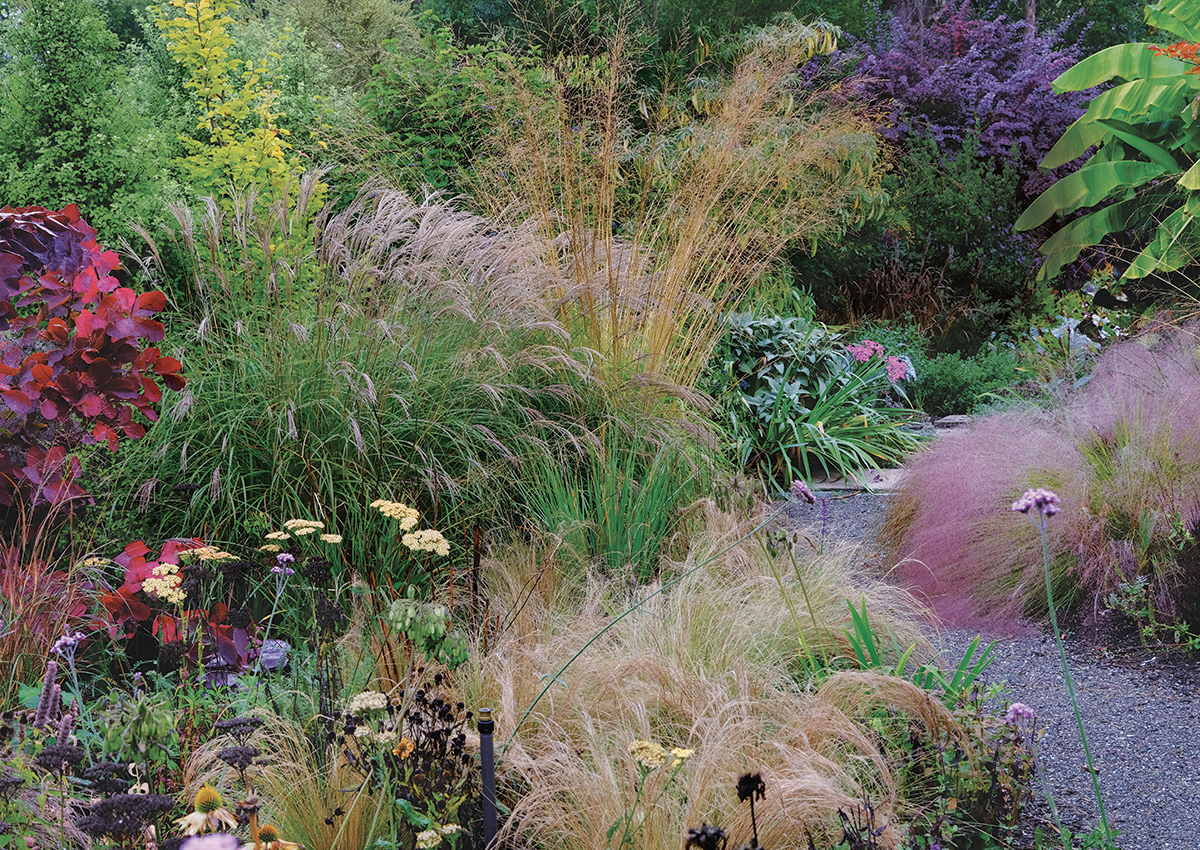
My border is actually divided in two parts, with the section that shares the property line with my neighbors being the larger of the two. The smaller, more narrow bed to the left was also planted with a backbone of grasses. Here I mainly chose groupings of medium or short grasses, so I didn’t obstruct the views to the water when strolling in the garden or sitting in the chairs at its middle. Sweeps of the same varieties as well as repetition on both sides of the path keep the border looking like a truly grass-forward garden. Also, I didn’t always put the tall stuff in the back and the short stuff in the front. Instead, to give more movement throughout, I added tall and short plants along the path. This created hidden pockets in between, where other interesting perennials could be placed.

Follow an Ornamental Grass Garden Through the Seasons
The border I created certainly relies heavily on ornamental grasses to form the backbone of the bed. But the supporting cast of perennials, evergreens, and even bulbs ensures there is interest during all 12 months.
Spring provides subtle hints for what’s to come
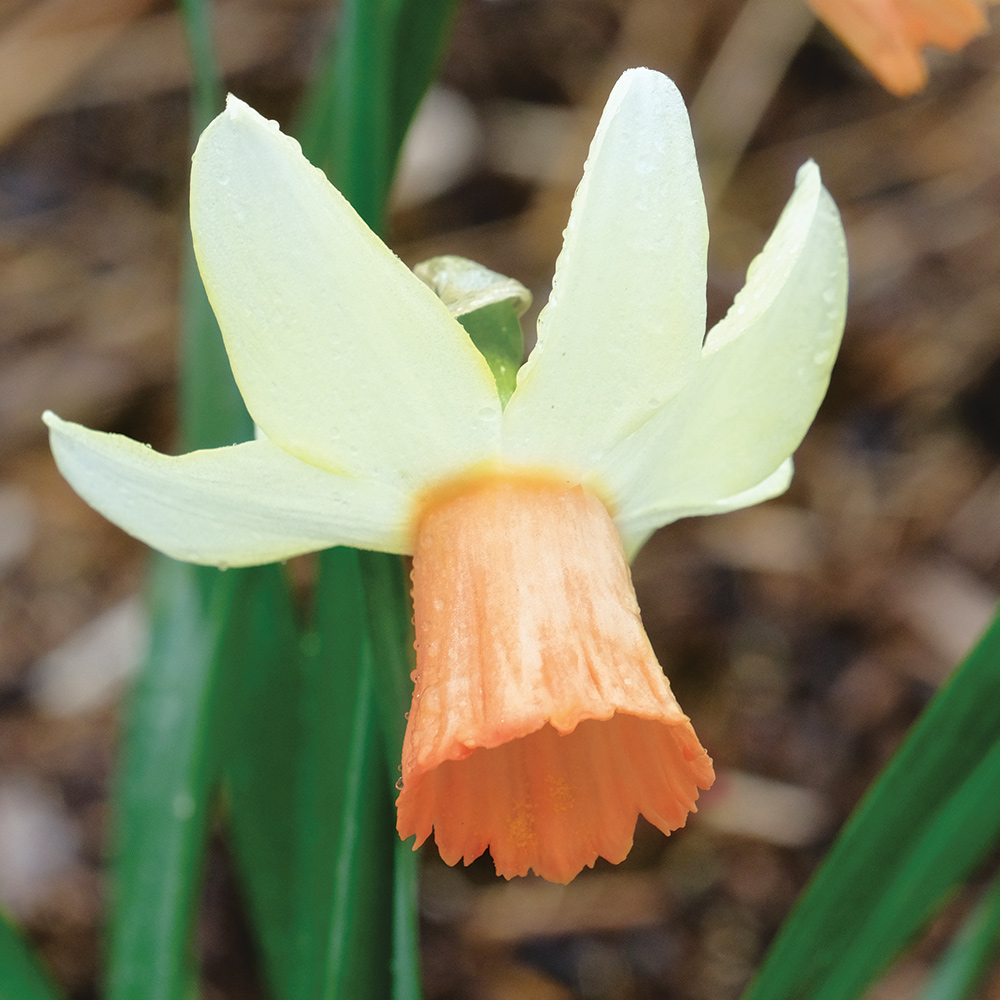
Things are pretty quiet in the spring grass garden. This is the season when the importance of hardscaping and clean, polished edges becomes apparent. These structural details provide subtle interest. This is also when areas beyond the beds, which are usually hidden, come into view. I ensure that select evergreens and a few deciduous shrubs with dense habits provide screening for anything truly unsightly. These bones also add structure and help frame the view to the water. Select bulbs such as ‘Winter Waltz’ daffodil with its lovely apricot and cream blooms give a hint of the color scheme to come. Fresh greenery from emerging perennials livens up the scene, while evergreen Mexican feather grass still stands tall, creating repetition along the pathway and reminding everyone this is still a grass garden. Just remember that this is not the time to add anything to the beds and borders. Even though there are blank spots now, they will fill in quickly, and bulky dormant grasses are just waiting for a bit of warmer weather to push their way out.
- Japanese stewartia (Stewartia pseudocamellia, Zones 5–8)
- ‘Little Gem’ Southern magnolia (Magnolia grandiflora ‘Little Gem’, Zones 7–9)
- Mexican feather grass (Nassella tenuissima, Zones 7–10)
- American hornbeam (Carpinus caroliniana, Zones 3–9)
- ‘Winter Waltz’ daffodil (Narcissus ‘Winter Waltz’, Zones 3–9)
- ‘Spring Cream’ Tasmanian leatherwood (Eucryphia lucida ‘Spring Cream’, Zones 8–10)
- Boxleaf azara (Azara microphylla, Zones 7–9)
Summer is when supporting perennials truly shine
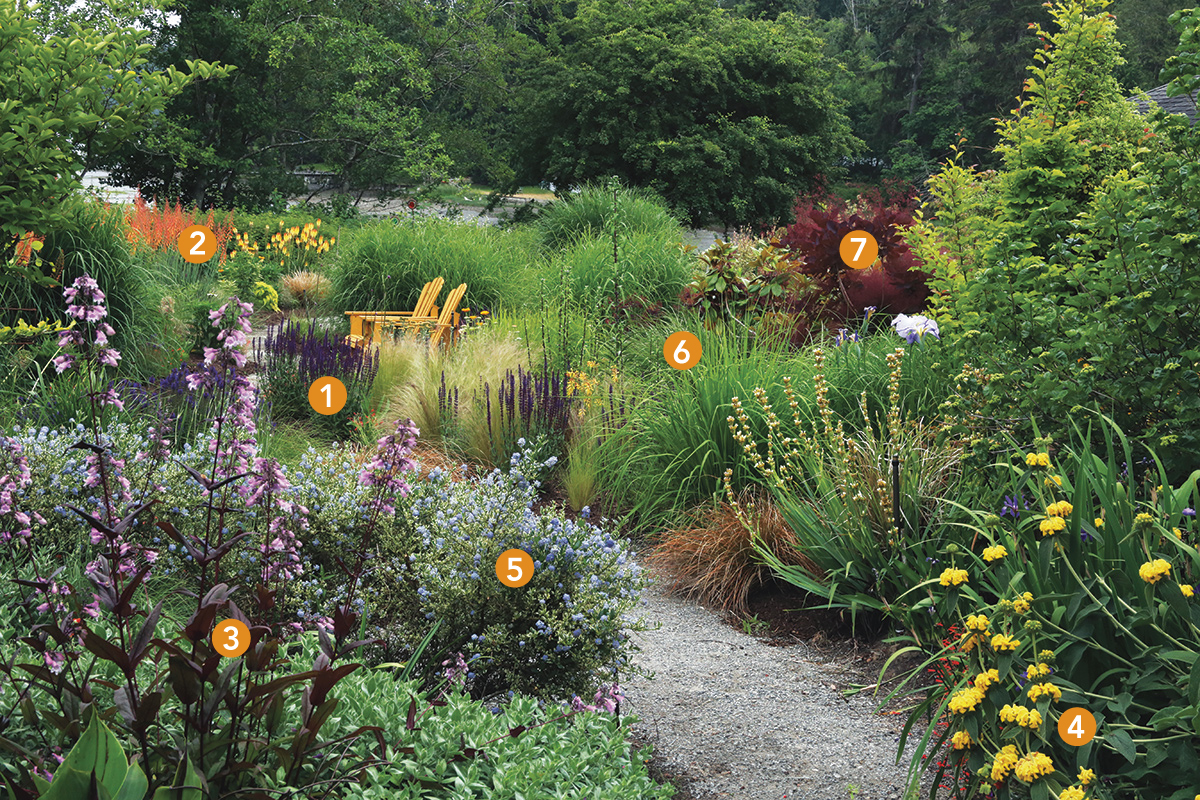
It is hard to determine the best season in the grass garden, but this is close! The grasses are lush, green, and about halfway to their mature height. The view into the garden is still open, and all of the border can still be seen at once. Various hues of orange, purple, apricot, and yellow from companion perennials are brilliant against the fine-textured green blades. ‘Caradonna’ salvia provides a wonderful dark purple bloom, and the stems remain plum-colored after flowers are gone. It can be left to fade into fall or cut back, if you’d like a rebloom. Red-hot pokers make fabulous focal points on each side of the garden, drawing you down the path. They also rebloom all summer long. Framing the entry are two more pops of intense color from ‘Dark Towers’ penstemon and Turkish sage, while an emerging purple smoke tree stops your eye at the midway point, forcing you to take in the various layers of the bed and the small vignettes between the taller grasses that are just becoming evident.
- ‘Caradonna’ salvia (Salvia nemorosa ‘Caradonna’, Zones 4–8)
- Thomson’s red-hot poker (Kniphofia thomsonii var. snowdenii, Zones 6b–9)
- ‘Dark Towers’ penstemon (Penstemon ‘Dark Towers’, Zones 3–8)
- Turkish sage (Phlomis russeliana, Zones 5–9)
- ‘Cool Blue’ California lilac (Ceanothus thyrsiflorus ‘Cool Blue’, Zones 5–9)
- ‘Skyracer’ purple moor grass (Molinia caerulea subsp. arundinacea ‘Skyracer’, Zones 5–8)
- ‘Royal Purple’ smoke tree (Cotinus coggygria ‘Royal Purple’, Zones 4–9)
Fall allows the grasses to become the undisputed focal point

While many regular gardens start to go dormant in October, that’s not the case with a grass-forward garden—it is just hitting its peak. While this type of garden is lovely and interesting most times of the year, its autumnal changes in color and form can take your breath away. Ornamental grasses start to flower and turn vibrant colors of yellow, red, burgundy, and—perhaps most surprising of all—flamboyant pink. The pathway all but disappears, but flower panicles from the grasses draw you down the path and into the last section of the border. The sitting area is surrounded by the rustling foliage, scent, and misty clouds of muhly grass. Completely enclosed, it feels like a world apart from other areas of the landscape. Groupings of ‘Fast Forward’ muhly grass repeat rhythmically and keep your eye moving along the border. Seed heads from coneflowers and lily of the Nile stand stiffly in the wind, while deciduous leaves of the Japanese stewartia tree turn bright orange, and late bloomers such as dahlias vie for attention.
This is the time of year when it becomes most obvious that there are many types of grasses planted here. The layers they create intermingle, showing off various forms and colors. It’s the interaction between the grasses themselves that makes this border interesting. Unlike in other gardens, the blooming perennials here are just accents, not the whole show.
- ‘Alhoa’ coneflower (Echinacea ‘Aloha’, Zones 3–8)
- Lily of the Nile (Agapanthus cv., Zones 6b–9)
- Dahlia (Dahlia cv., Zones 8–10)
- ‘Blackhawks’ big bluestem (Andropogon gerardii ‘Blackhawks’, Zones 3–9)
- ‘Fire Dragon’ miscanthus (Miscanthus sinensis ‘Fire Dragon’, Zones 5–9)
- Fast Forward’ muhly grass (Muhlenbergia capillaris ‘Fast Forward’, Zones 6–10)
- Japanese stewartia
Winter leans into the beauty of dormant plants
This is the time of year when the value of a grass garden to local wildlife becomes most evident. Birds, small mice, and squirrels are busy devouring the various seed heads of spent grasses and making nests under the foliage. I leave the grasses uncut until early spring to provide shelter and food to local critters. And even then, I do my cleanup carefully. (Lower grasses have mice nests under the foliage, so I leave those undisturbed.) The evergreen plants are easy to see, contrasting with the dominant buff, mahogany, and wheat colors. Sun rose, fairy wand, Mexican feather grass, and Crystal Falls® mondo grass provide evergreen repetition along the path. ‘White Cloud’ muhly grass is the very last variety to bloom in this garden and is still green at this time of year, while a rare sedge provides additional evergreen structure. The tallest grasses remain upright through most of the winter months, providing privacy screening and shelter from strong winds.
- ‘Cheviot’ sun rose (Helianthemum nummularium ‘Cheviot’, Zones 5–8)
- ‘Blackberry Bells’ fairy wand (Dierama pulcherrimum ‘Blackberry Bells’, Zones 7–10)
- Mexican feather grass
- Crystal Falls® mondo grass (Ophiopogon jaburan ‘HOCF’, Zones 6–11)
- ‘White Cloud’ muhly grass (Muhlenbergia capillaris ‘White Cloud’, Zones 6–10)
- Pale yellow-eyed grass (Sisyrinchium striatum, Zones 5-9)
- ‘Skyracer’ purple moor grass
Susan Calhoun is the owner and principal designer of Plantswoman Design in Bainbridge, Washington. She is also a FineGardening.com regional reporter for the Pacific Northwest.
Photos, except where noted: courtesy of Susan Calhoun
Fine Gardening Recommended Products

Planting in a Post-Wild World: Designing Plant Communities for Resilient Landscapes
Fine Gardening receives a commission for items purchased through links on this site, including Amazon Associates and other affiliate advertising programs.

Berry & Bird Rabbiting Spade, Trenching Shovel
Fine Gardening receives a commission for items purchased through links on this site, including Amazon Associates and other affiliate advertising programs.


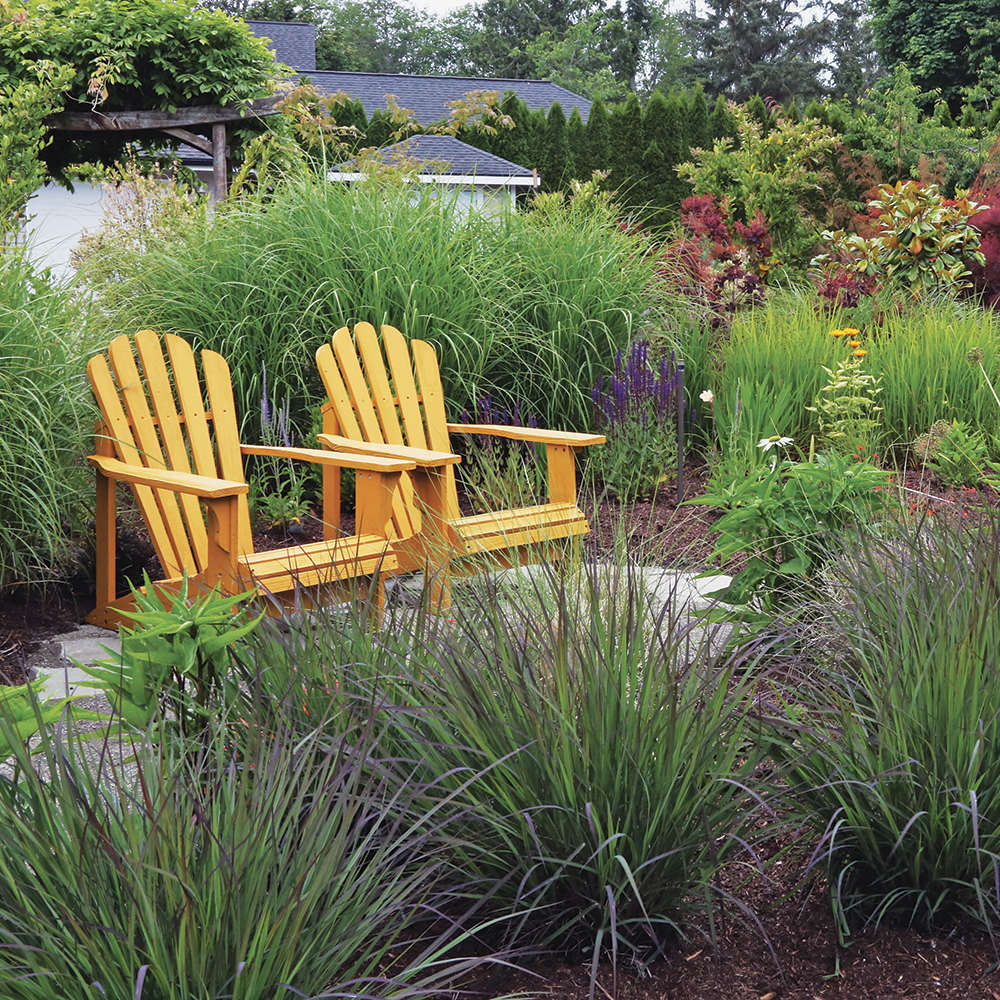


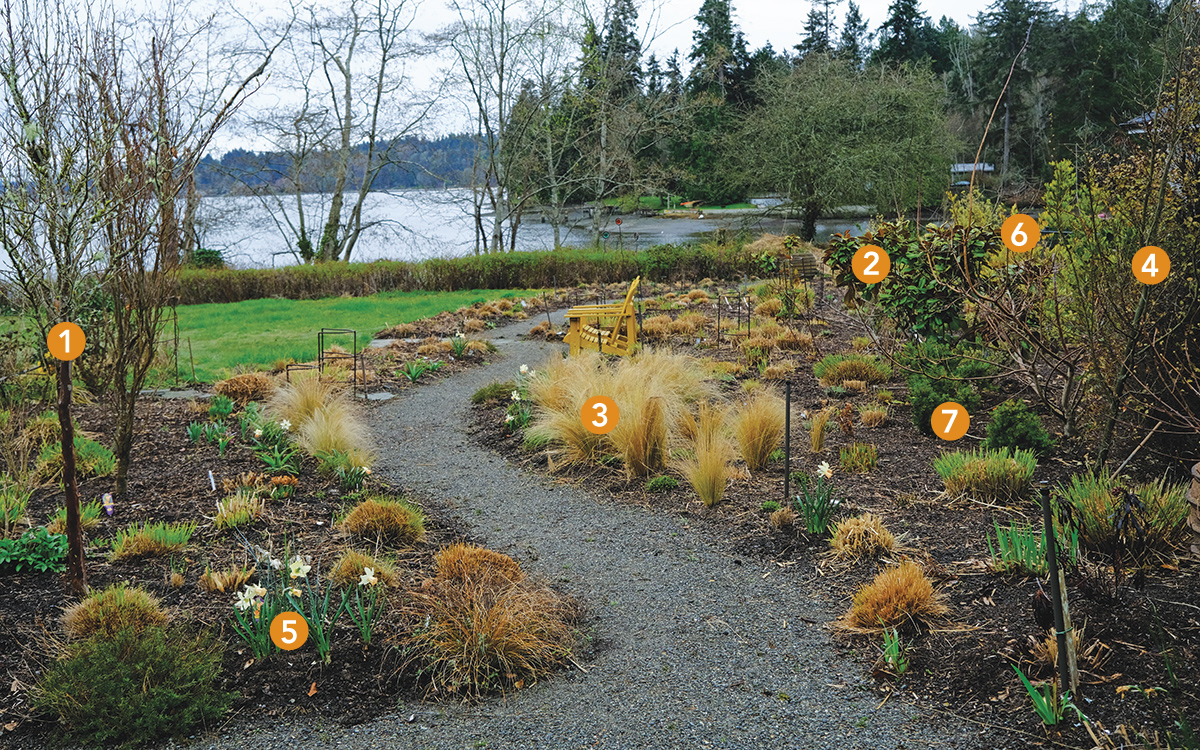

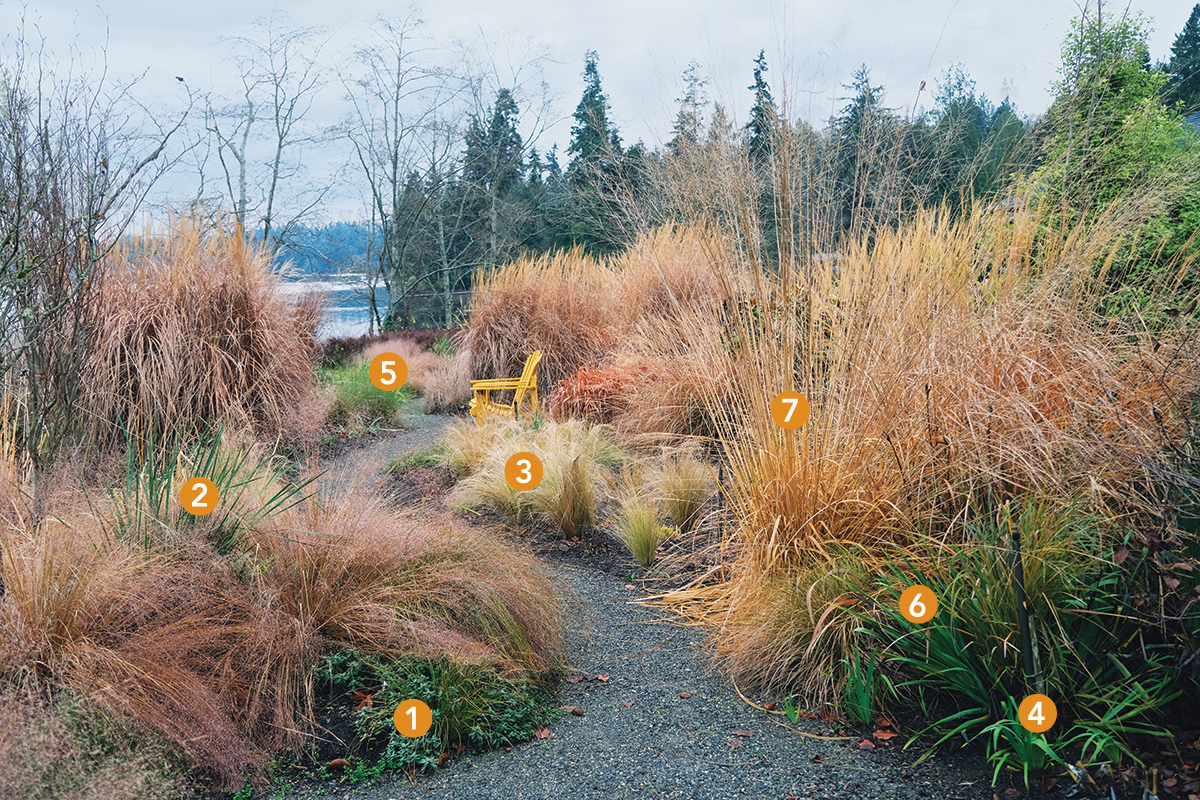





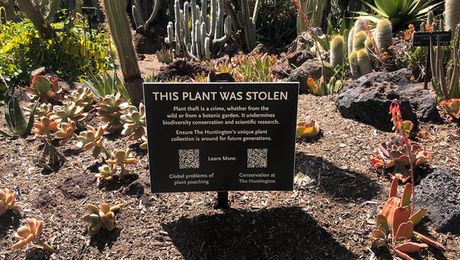











Comments
Log in or create an account to post a comment.
Sign up Log in